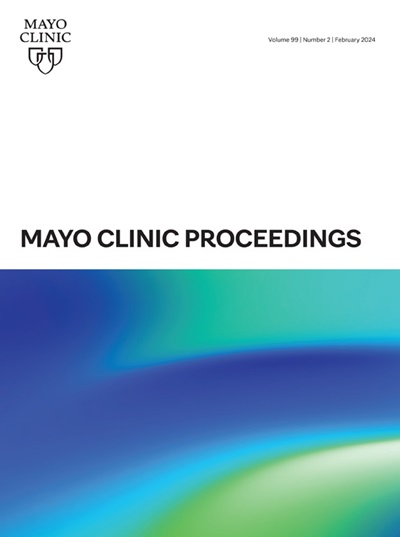经皮冠状动脉介入治疗后肾功能和急性肾损伤对长期预后的影响。
IF 6.7
2区 医学
Q1 MEDICINE, GENERAL & INTERNAL
引用次数: 0
摘要
目的:探讨经皮冠状动脉介入治疗(PCI)后急性肾损伤(AKI)的发生率、预测因素及预后意义。患者和方法:回顾性分析梅奥诊所PCI注册表,确定了2009年1月1日至2023年6月30日期间接受PCI治疗的9199例患者。结果:共有856例(9.3%)患者发生AKI(血清肌酐水平升高≥0.3 mg/dL或≥1.5倍基线),其中87例(0.9%)患者需要血液透析。观察到AKI的年发病率呈单调上升趋势(p结论:PCI术后AKI的发病率在当代仍然很高。PCI术后发生AKI的患者住院死亡率、长期死亡率和不良心脏事件发生率较高。本文章由计算机程序翻译,如有差异,请以英文原文为准。
Impact of Renal Function and Acute Kidney Injury on Long-term Outcomes After Percutaneous Coronary Intervention
Objective
To determine the incidence, predictors, and prognostic implications of acute kidney injury (AKI) after percutaneous coronary intervention (PCI).
Patients and Methods
Retrospective analysis of the Mayo Clinic PCI registry identified 9199 patients who underwent PCI from January 1, 2009, through June 30, 2023.
Results
A total of 856 patients (9.3%) developed AKI (increase in serum creatinine level by ≥0.3 mg/dL or ≥1.5 times baseline), with 87 (0.9%) requiring hemodialysis. A monotonic increase in the yearly incidence of AKI was observed (P<.001). In multivariable analysis, AKI was associated with older age (odds ratio [OR], 1.01; 95% CI, 1.00 to 1.02), female sex (OR, 1.27; 95% CI, 1.08 to 1.49), diabetes (OR, 1.62; 95% CI, 1.38 to 1.89), congestive heart failure (OR, 2.99; 95% CI, 2.54 to 3.52), chronic kidney disease (OR, 2.46; 95% CI, 2.00 to 3.02), acute myocardial infarction (OR, 3.34; 95% CI, 2.80 to 3.99), intra-aortic balloon pump (OR, 3.49; 95% CI, 2.55 to 4.73), and contrast volume (OR, 1.28; 95% CI, 1.17 to 1.41). In-hospital mortality was 11.1% vs 1.0% in patients with vs without AKI (P<.001). After adjustment, AKI remained strongly associated with in-hospital mortality (hazard ratio, 5.75; 95% CI, 4.06 to 8.13). Among hospital survivors, 1-, 5-, and 10-year all-cause mortality, repeated revascularization, myocardial infarction, and major adverse cardiovascular event rates were significantly higher in those who developed AKI.
Conclusions
The incidence of AKI after PCI remains high in the contemporary era. Higher in-hospital and long-term mortality and adverse cardiac event rates were noted in patients who developed AKI after PCI.
求助全文
通过发布文献求助,成功后即可免费获取论文全文。
去求助
来源期刊

Mayo Clinic proceedings
医学-医学:内科
CiteScore
16.80
自引率
1.10%
发文量
383
审稿时长
37 days
期刊介绍:
Mayo Clinic Proceedings is a premier peer-reviewed clinical journal in general medicine. Sponsored by Mayo Clinic, it is one of the most widely read and highly cited scientific publications for physicians. Since 1926, Mayo Clinic Proceedings has continuously published articles that focus on clinical medicine and support the professional and educational needs of its readers. The journal welcomes submissions from authors worldwide and includes Nobel-prize-winning research in its content. With an Impact Factor of 8.9, Mayo Clinic Proceedings is ranked #20 out of 167 journals in the Medicine, General and Internal category, placing it in the top 12% of these journals. It invites manuscripts on clinical and laboratory medicine, health care policy and economics, medical education and ethics, and related topics.
 求助内容:
求助内容: 应助结果提醒方式:
应助结果提醒方式:


